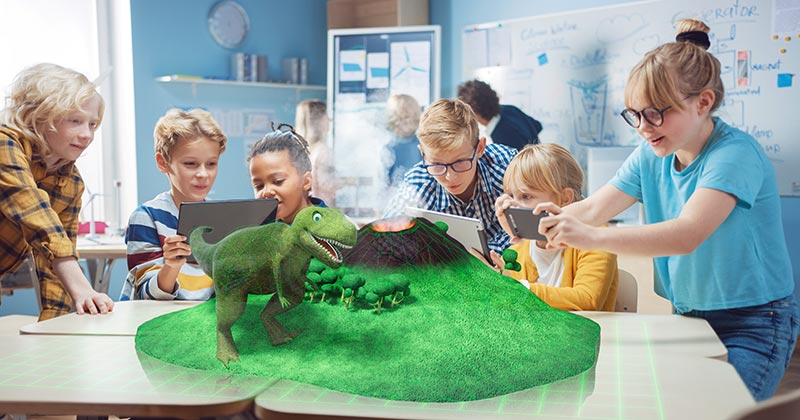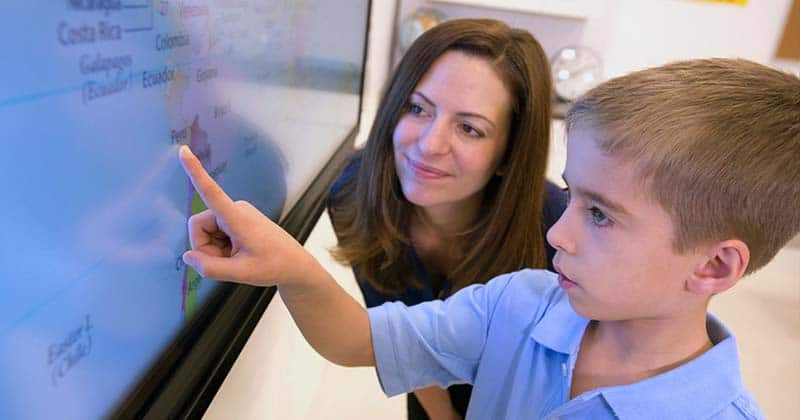Creating an engaging learning environment can be a challenge at times for any classroom teacher. But you really want your students to be engrossed in the subject you’re teaching.
When kids are engaged and attentive, I’ve found that they’re better listeners and respond quicker to instructions. Plus, they look like they’re learning and having fun.
Here are several ways to help engage with students and make the classroom more interesting, light and beneficial for learning. I’ve based these on my own experiences as a late-elementary school teacher. But the student engagement strategies also draw on research into what’s effective across all age groups.
1. Make Classes Interactive

Unless you are a truly fantastic presenter, your students could become bored very quickly when they’re only hearing you talk. Involving your students in discussion is a time-honored method to keep attention levels up and manage a classroom effectively.
One of the best ways to gauge your students’ understanding is to ask questions or let them ask questions. Give the students a chance to give their opinion over debatable issues and encourage open dialogue.
You should let your students be part of the class as much as possible. Interactivity is vital for struggling students and can be used to engage advanced students as well.
Here are some great tips from the Resilient Educator on how to make classes interactive.
2. Create Classroom Games

Everybody likes playing games of some sought. Whether at an elementary or higher education level, playing games is a classic method to activate the student’s thoughts and engage them in the topic.
You can create competitive games in a class where students try to outshine each other in groups or as individuals. Engage students by asking them to be the quickest to come up with a list (e.g. Who can name three cities in Florida?) or be the first person to guess the name of an historical figure based on clues you provide.
Mind-challenging games, academic puzzles and even science toys (such as terrariums, specimen rocks and microscopes) and can also be incorporated into lessons to help with cognitive development. The novelty factor of games and objects is a good way to increase student engagement and often doesn’t require much planning.
As well as educational games, you can create some quick fun games to help children release energy and look forward to going to the next class. Some of the 40 examples from Christopher Olson are: Scrambled Eggs (observation), 20 Questions (guessing), Sparkle (spelling) and hot potato (luck).
If you’re looking to jazz up student engagement, how about introducing some fun online games into the mix? Education platforms have interactive games designed especially for learning. Blending offline and online games can liven things up, making the classroom environment dynamic and enjoyable.
3. Give Students Choices

Do your students have any say over what happens in your class? The class will feel appreciated and gain enthusiasm when you involve students in decision making. For example, for an evolutionary biology subject, you could let students choose between doing a project on dinosaurs or modern reptiles.
No matter how young they may be, students have ideas that might help improve the learning environment. You can do this without handing over control, such as to give them options to choose from or create a learning activity that requires decision making.
To find opportunities to offer choice, focus on outcomes rather than tasks. Some examples are to allow students to choose: (a) which of three titles on the same topic they’ll write under (b) the order in which they complete tasks (c) which questions on a subject they’ll answer in detail (d) whether the class does an activity at the start or end of the lesson (e) the reward for completing work on time.
4. Use Technology

Technology usually arouses people’s interest, even us grownups. Students love experimenting with devices such as tablets, phones and computers. Technology and videos, when used in the classroom sparingly, form an effective way to get students interested in the lesson.
If you choose to use technology, try to really connect the technology to learning rather than allowing it to be a distraction from subject. Engaging students in the subject is the goal rather than having them immerse themselves in the digital technology itself.
Students generally love technology and introducing it is a way to boost engagement. You can also apply technology to get more information from reserved students.
Future Educators
Including online communication is also a way to start teaching netiquette to older children. Generally, you need to use academic standard approved devices, software and other online resources that are optimized for the classroom environment.
5. Relate Material to Students’ Lives

Learning materials that relate to real life boost student engagement immediately and are often more memorable. If you realize that your students seem to be losing attention or do not understand what you’re teaching, try to inject real-life examples.
For instance, if a student asks you why you teach about money, do not use a “because” answer. Use a practical life example such as, “We need money to buy things in life.” You can make it clear by demonstration or using examples drawn from your own life or from shows or characters the children might be familiar with.
Some more tips from Janelle Cox are to: (a) do a news search on the topic (b) invite a guest speaker or show a relevant video of them (c) take a field trip (d) simulate a real-life experience such as by having some of the students act out a hypothetical event and (e) give students problems to solve or explore based on case studies instead of purely hypothetical scenarios.
6. Incorporate Mystery In Your Lessons

Find a way of creating suspense in your lessons. You can give students hints about your next lesson and tell them to find out more information. You can even set a reward for the students who discover things on their own.
Find something each time to turn the lesson into a bit of a problem solving quest. Using mysteries and investigation can really boost the mood of the class. Don’t explain everything in a bland sequence. Get their minds ticking by giving hints or dropping important information without explaining everything straight away.
For example, in a history lesson, you could talk about a person or event without actually naming them or giving away what the topic is about exactly. You could start a lesson with, “Today, we’ll be discussing a famous American whose work still impacts everyone of us today. He wrote some of the most important rules about how our republic works.” Sometime later you can let them know that this person is named Thomas Jefferson.
Why It’s Important to Engage Students in Learning

Numerous research studies have found all sorts of positive correlations between student engagement and learning outcomes. In whatever way you measure how engrossed students are in classroom activities, we find that this helps predict test scores and other measures of learning performance. This is hardly surprising.
Students who are inattentive, withdrawn, and disengaged in the classroom have poorer academic performance when compared to engaged students.
Kathy Dyer
A fully disengaged student might was well be unconscious or not present in terms of active learning. They won’t learn a thing if they’re daydreaming about something else and otherwise not paying attention to the lesson. The higher the level of engagement, the greater the prospects of classes being effective.
Learning happens in the mind. Paying attention at least means a student is likely to retain some facts on a topic. If they’re really switched on, they might start making more complex connections and achieve insights. A highly engaged student won’t switch off when they leave the classroom and will continue learning, perhaps with the help of research or simply by continuing to think.
That’s why a fundamental responsibility of any teacher is to do your best to engage your students. And that doesn’t just mean ensuring everyone is cooperative and looking to the front of the classroom (though a well behaved student body is a good start). The best learning happens when you’re able to spark the imagination, curiosity and enjoyment of your pupils.
A fully engaged student will exhibit behavioral engagement (acting appropriately), cognitive engagement (actively thinking about the subject) and emotional engagement (positive feelings and genuine enthusiasm towards education).
Examples of Student Engagement
Engaging students in learning isn’t just about paying attention, it’s about a student’s curiosity, interest, optimism, and passion for learning.
Think about when students really dive into class discussions, voicing opinions, and asking questions. It’s not about just sitting back and listening, but stirring up debates and dialogues.
Collaborating in groups is also key. They’re not just along for the ride, they’re actively participating, communicating, and taking responsibility.
We live in a digital world, so online engagement is huge. It’s not just about consuming content but about participating in discussions and using interactive tools.
Hands-on learning is crucial too. It’s about getting stuck in and learning by doing. It could be in labs or practical sessions – creating, building, and manipulating concepts.
And don’t forget the positive attitudes towards learning. The real magic happens when students show curiosity, enthusiasm, and a genuine passion for what they’re learning.

Thanks for sharing these excellent ideas.
Thank you so much for your tips this is very helpful.
I’m going back to teaching next year. I haven’t been in front of a classroom in over 10 years. I decided to step down when I had my twins since my husband had taken on a big promotion. Now that I have more time and the kids are less dependent, I want to get back out there. I’m just not sure how kids are these days nor how to interact with them. I feel so out of the loop!
These are some great tips you have shared here, all the points are very helpful in making the class lively and getting students’ interest in the subject. Making studying fun, and interesting that is the ultimate thing and these are the steps for it. Thanks for sharing, they are f true help for new teachers, appreciate it.
It is so helpful finding articles that go over the basics that most experienced teachers don’t need reminding of. Being in college working towards the teaching profession, this is the stuff I need to read. One of the best ways for student engagement, in my opinion, is creating games for the kids. There may always be one or two students that never seem interested no matter what the teacher does. However, having the class play a Kahoot or another competitive game has never failed at getting everyone participating. I have seen this personally from a student’s perspective at every level of education.
This might seem like common sense for experienced teachers but it might not be for new teachers. I agree that you should make things interactive and cultivate an interest in participation. Setting rewards is a good way to do so but you should make sure it’s not driven entirely by rewards. Otherwise, the only motivation (at least for some students) will be rewards. I can speak from working with college students that we need to get kids involved at a young age so we can cultivate better learning habits.